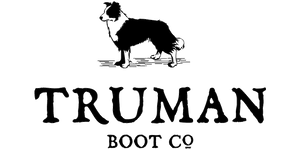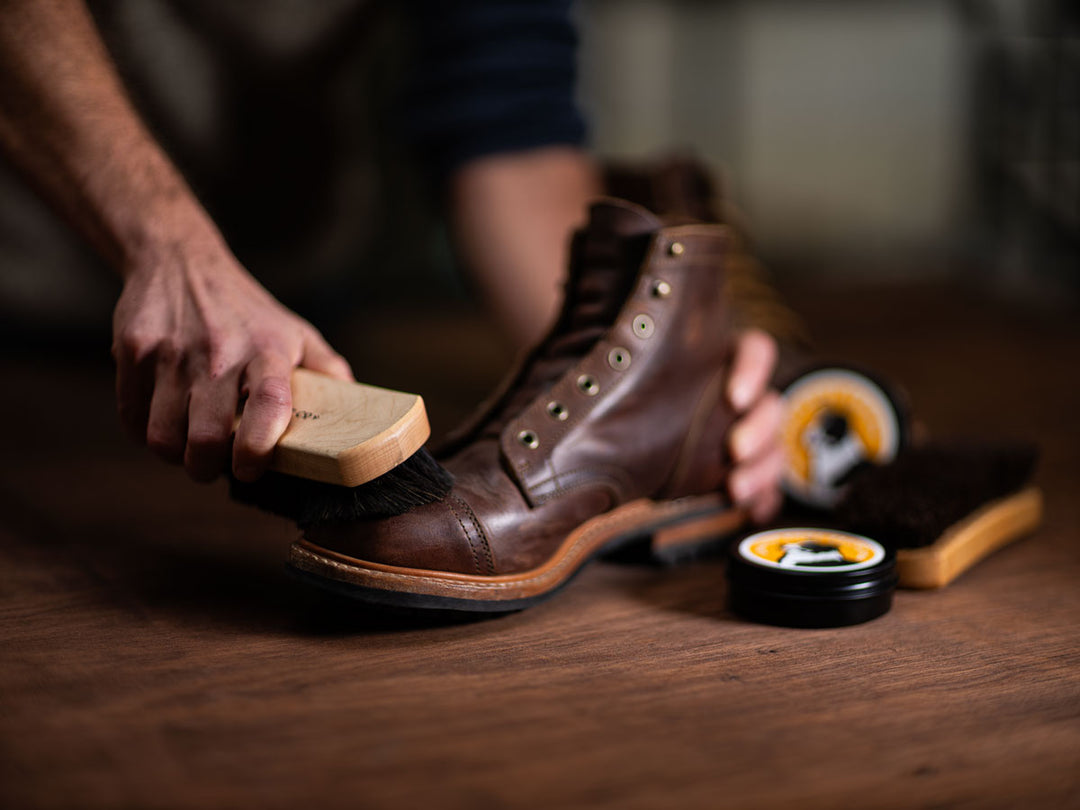The world of boot building is loaded with jargon and special terms, and so we've provided the following dictionary to help explain. If you have any questions about any of the terms, please reach out via chat and we'll get you sorted.
The Brannock device is a standard foot measuring tool, used worldwide, to determine the proper width, length and arch of one's foot.
Chromexcel is a combination-tanned leather, using a number of processes, including hot-stuffing, creating a very resilient and tough leather that ages beautifully over time. Only periodic conditioning and cleaning necessary for care.
As it sounds, this is the straight-edged leather cap at the front of cap-toe boots; occasionally styled with perforations creating a pattern referred to as “medallion” or “brogue.”
The classic work and hike outsole, made of rubber, featuring thick tread that lends to great traction and lifts the boot up away from the ground.
We use formed leather counters to hold the heel in place and provide stability. Positioned between the quarters, built into the counter pocket, or, placed between the heel lining and the heel leather where the counter pocket is not present.
The counter pocket is a piece of leather on the back side of the boot that holds the counter in place, helping to keep the boot's shape and help support.
A more formal sole that offers minimal traction and grip, originally created in reaction to British winter weather. After more than 100 years, the dainite sole still answers the need for a practical, lower profile sole.
Used to seal the leather of the midsoles and welting of our boots, as well as bringing out a rich, varied texture that almost resembles stained wood.
A small piece of circular-shaped hardware that is used to reinforce the hole through which laces are pulled; variably available in polished brass, antiqued brass and gun metal.
A single back piece of leather, taking the place of our standard remove pull heel and counter pocket, situated along the backside of the boot.
As differentiated from the storm welt, flat welt is a style of Goodyear welt made with a flat piece of leather as the connection between the upper and the midsole.
Full grain leather refers to hides that have not been split, sanded, corrected or buffed, making for the strongest, toughest, tightest grained leather possible.
Genuine leather is used to describe the lowest quality leather, usually made from finely ground leather scraps that have been reconstituted into a piece of “leather” using a variety of chemicals and adhesives.
The
Goodyear Welt is a construction technique in boot-building that had its start in 1869. Goodyear’s process consisted of a special insole channelled to provide a “lip” or “rib,” in which the upper was then pulled over the last to this rib, which was temporarily held in place by tacks, wire and staples. A flat strip of leather called a “welt” was then sewn to combine the welt, upper and lining to the “rib” using a chainstitch method of sewing. After the welt was sewn, the shoe was then joined to the outsole by sewing through the welt and then out the welt with a lockstitch. For more information about our Goodyear welt, check out our welt-specific page,
here.
Leather grain refers to the appearance and composition of the surface of the leather. The tightness of the grain will depend on the animal and the differing densities of hair and fur.
A gusseted tongue is a type of tongue where the leather is attached to the upper, by way of the quarter, behind the laces, preventing dirt and debris from entering the boot.
A half-sole is a rubber sole that only covers the bottom of the front portion of a boot. This is a lighter weight, more flexible sole than a full sole.
The experience, often with a new boot, wherein when walking, one can feel their heel shift in boot; usually dissipating with time and break-in, but can indicate the last used to build the boot does not work for the foot.
Horse rump, or horse butt, is perhaps one of the most coveted leathers in footwear. The tight grain of the leather provides exceptional water resistance and durability, and due to the longer lifespan of horses, there is more variability in the hides.
Commonly referred to as an “insole,” an insert is the part of the boot that the bottom of the foot or sock is in contact with. We use leather inserts that are adhered to the footbed.
The instep of the foot is the bony structure on top of the foot, towards the forefront, from the front of the ankle to the back of the toes.
Kudu is a species of antelope in Southern and Eastern Africa, whose environment is bushy and is shown in the texture created on the surface of the hides.
A last is the foot-shaped mold used to shape the sewn leather into a boot or shoe. Lasts can be made from a variety of materials, and traditionally of wood.
We have three proprietary shoes lasts; the 79 last, the 20 last and our latest last, the 56.
The step in boot building where the upper is nailed into place and stretched over the last. This is done by hand and/or machine; we use a combination for a consistent tension and shape.
The midsole sits between the outsole and the upper and insole. At Truman, we use a solid natural vegetable-tanned midsole, primarily attached using Goodyear welting.
A boot makeup is essentially a recipe for a boot; including the heel style, leather, hardware finish, last, and sole.
The moc toe is a style of toe that features a two piece vamp with a thick, often contrasting, stitch that goes around and along the front of the vamp; this aesthetic is pulled from hand-sewn moccasins.
The outsole is the outermost part of the boot that comes into contact with the ground. It is made from a variety of materials, and in a variety of styles including full, half and lugged soles.
Patina is a word borrowed from the metal world, used to describe the chemical change in the surface of a metal when exposed to different elements, such as the change in copper from deep rosy gold to aqua green. The surface of different leathers will also change, largely depending on the tanning process, the hides themselves, and lifestyle of the boot owner.
A style of vamp wherein the toe is a single piece of leather without embellishment.
A loop of leather on the backside of the boot that increases ease of putting on the boot.
Pull-up describes leather that has been so stuffed with waxes, fats and liquors, that when pressure is applied to the leather in the form of pinching, squeezing or pulling, the color will temporarily change as the oils disperse away from the pressure.
The piece of leather that comprises the side parts of the boot, one quarter piece on the right side-face of the boot and a piece on the left side of the boot.
A more minimal heel style up the back of the boot that does not feature a loop at the top for pulling boots on.
Each hide has two sides: 1.) the side where hair grew is called the smooth out side; and 2.) the side that was internal on the animal is referred to as “rough out.”
A piece of steel, fiberglass, Kevlar or wood used to provide integral strength to the footbed, and diminish strain on the heel and calf.
Each hide has two sides: 1.) the side where hair grew is called the smooth out side; and 2.) the side that was internal on the animal is referred to as “rough out.”
A piece of hardware used on boots, usually in combination with eyelets, to allow for quicker lacing and unlacing. Especially common on tall boots.
In constructing our heels, we use layers of stacked and glued vegetable tanned leather, with a rubber top-lift adhered and nailed to the stack.
A method of construction where the upper is flared out and sewn to the midsole and outsole using a double-stitch method.
As differentiated from the flat welt, a style of Goodyear welt that uses a piece of leather with a ridge that fits snugly up against the upper, creating a perceived gain in water resistance.
Used to describe the leather piece sewn up the backside of the boot, both with an external counter pocket, as well as without.
A method of adding a piece of reinforcing material in between the lining and the vamp, helping to hold the shape of the toe for a longer duration of time.
From the French “gants de Suède” meaning gloves from Sweden; suede is made from the underside of the hide, usually split, and as a result, is a softer, more pliable leather with a nappy (hairy or shaggy) finish texture and appearance.
The process used to take an animal hide and convert it into a stabilized material (leather) suitable for using in the construction of durable products, such as boots, shoes and handbags.
Akin to the outsole, the top-lift is the bottom-most piece of the heel that comes into direct contact with the ground; made of a variety of materials, commonly a rubber compound.
Top grain describes leather where the top layer of the hide has been used in one of two fashions, split and corrected, or uncorrected. Full grain leather is a top grain leather that has not been corrected or split.
The tongue of the boot is the piece of leather behind the laces that cushions the instep and spreads out the pressure from the laces.
In contrast to the structured toe, the unstructured toe forgoes the reinforcing material in the toe, resulting in a shape defined more by the foot over time, than the last on which the boot was built.
The upper is everything above the midsole, including the quarter, the vamp, counter pocket and/or strip back.
The vamp is the front part of the boot, from the toe back to the quarter. Can feature a plain or cap toe.
The oldest tanning process, using extracts from plants and trees to stabilize the leather, in contrast to using chromium salts as in chrome tanning.
Waxed flesh is a leather tanned by Horween, and is one of the first leathers we adopted as our own. It uses the rough out side of the hide, that is deeply waxed and buffed to create an initial smooth waxed finish. As the leather bends and creases with use, the wax breaks and a lighter nappy under layer is revealed, resulting in a one-of-a-kind patina.
The welt is a strip of leather around the perimeter of the boot or shoe that holds the shoe together, connecting the upper to the mid and outsoles. There are a number of styles of welt including Goodyear, Stitchdown and Blake welting. We primarily use Goodyear welting as through years of resoling our boots, we have found Goodyear welts to be significantly more resolable, and therefore, ultimately a longer lasting boot.
A sole comprised of a single wedge of rubber that runs the length of the boot. This eliminates the gap created between the heel and the outsole on a typical boot, leading to a larger contact area with the ground, which lends itself to greater comfort.






